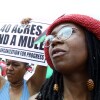Segregation-Era Law Puts Affordable Housing Approval in the Hands of L.A. Voters

This article was produced with UT Community News, which is produced by Cal State L.A. journalism students and covers public issues on the Eastside and South L.A.
Los Angeles' Proposition LH, a measure up for a vote in the November 8 election, would allow the city to approve as many as 75,000 new affordable housing units for low-income and unhoused residents.
That's 5,000 units for each of L.A.'s 15 districts.
In 2008, city of L.A. voters approved a ballot measure authorizing 3,500 units of low-income housing per council district, a total of 52,500 units in the city. Now, several council districts are approaching their allowed limit.
Requiring voter approval to authorize potential additional housing is a practice unique only to the state of California, according to Jane Demian, a tenants' rights activist and homelessness liaison to the Eagle Rock Neighborhood Council.
Article 34 ... was supported by real estate interests that were racist and supported racial segregation.Jane Demian, homelessness liaison for the Eagle Rock Neighborhood Council
That's because of Article 34 — a.k.a. the "Public Housing Project Law," a 72-year-old relic of racial segregation that still resides in the California Constitution today.
"Article 34 amended the California Constitution back in the 1950s to prevent public housing from being built in California. It was supported by real estate interests that were racist and supported racial segregation," said Demian in a statement to UT Community News.
The article creates an additional barrier for cities who seek to add additional public housing: It requires municipalities to first seek approval from the voters before approving new housing units. This is done through a ballot measure such as Proposition LH.
Kicking the Can
Article 34 harkens back to a time when many California voters feared racially integrated neighborhoods.
"The constitutional amendment was designed to keep people of color and poor people out of certain neighborhoods," said State Sen. Scott Wiener in a statement on his website.
Barriers posed by Article 34 restricted housing access for decades in counties like Humboldt, which didn't vote to authorize public housing until 2020, according to a study by Ballotpedia, a nonprofit that compiles research on federal, state and local politics, elections and public policy in the United States.
Legislators have led a handful of efforts over the years to repeal Article 34 from the state constitution, a change that requires majority votes from both state bodies — the State Senate and State Assembly — before voters can weigh in. The most recent push, in 2019, received a unanimous vote in the Senate but efforts fell apart in the Assembly due to a lack of interest from lobbying groups needed to fund the ballot campaign.
Getting an initiative on the ballot costs millions, and no sponsors volunteered to finance the campaign ahead of the Senate vote. Instead, lawmakers pushed efforts back to the next presidential cycle.
"The issue of repealing Article 34 by Constitutional Amendment will be put on the November 2024 ballot. I have been in favor of repealing Article 34 for years," Demian said. Until then, voters throughout the state will continue to approve marginal increases to public housing every few years through costly ballot measures like Proposition LH.
Help for the Unhoused?
Natalie Vargas, 18, says that she supports Proposition LH because of her own history of becoming homeless, when her mother left her father in 2017.
"We didn't have anywhere to go," Vargas said. "We slept in our car or in a storage area behind my grandmother's house."
Vargas, who now lives in East Los Angeles, said she lived like that for over a year.

Although East Los Angeles is just outside the city's boundaries, in unincorporated Los Angeles County, Vargas believes the measure would benefit a lot of people nearby.
"I think building low-income housing is necessary. Not only were there people who were homeless before the pandemic, but there are families who struggled during COVID who are now homeless," she said.
Not a Question of Funding
If Proposition LH were to pass, it would not directly fund affordable housing efforts. The money would come from existing funding — like California's Homekey program, for which Gov. Gavin Newsom recently announced the awarding of $694 million for 35 projects to create more than 2,500 new units throughout the state.
"In partnership with cities and counties like Los Angeles, we'll continue to safely house Californians in need, faster and more cost-effectively than ever," Newsom told reporters at a Project Homekey event in Los Angeles.
There's also bond financing that voters have already approved, like L.A.'s Measure H, a sales tax revenue stream dedicated to addressing homelessness.
More Housing News
However, the proposition would not require the city to generate additional units. Whether Los Angeles lawmakers choose to build or purchase these additional units is up to their discretion.
Opponents to Proposition LH, including some existing landlords and homeowners, say an influx of new housing could reduce their existing property values and create more traffic and other strains on resources.
Opponents to similar housing legislation say other housing measures exist and tax funds should be spent elsewhere, though no opposition statement against Measure LH has been filed in the City Clerk’s voter information pamphlet.












